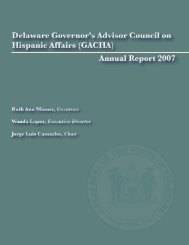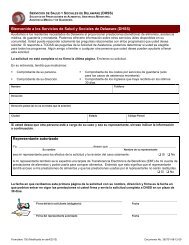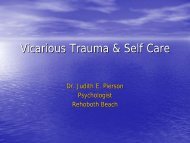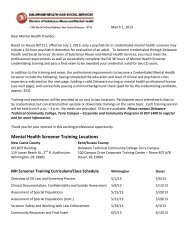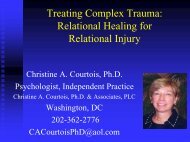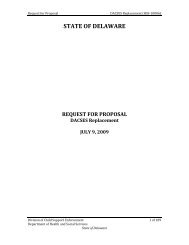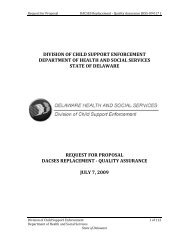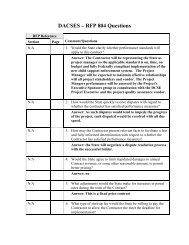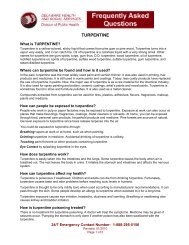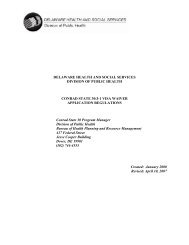CADMIUM - Delaware Health and Social Services
CADMIUM - Delaware Health and Social Services
CADMIUM - Delaware Health and Social Services
You also want an ePaper? Increase the reach of your titles
YUMPU automatically turns print PDFs into web optimized ePapers that Google loves.
<strong>CADMIUM</strong><br />
What is <strong>CADMIUM</strong>?<br />
Cadmium is a soft, bluish-white metallic element that occurs naturally in the earth’s crust. It is often found as a<br />
mineral combined with other elements like oxygen, chlorine <strong>and</strong>/or sulfur.<br />
Where can cadmium be found <strong>and</strong> how is it used?<br />
Soil, rocks, coal <strong>and</strong> fertilizers contain cadmium. Most of the cadmium used in the United States is removed<br />
when other metals such as zinc, lead <strong>and</strong> copper are processed. Cadmium is used in some nickel-cadmium<br />
storage batteries, pigments, metal coatings, dental amalgams <strong>and</strong> plastics.<br />
Cadmium can enter the air from mining, industry, burning coal <strong>and</strong> household wastes. Cadmium can travel<br />
long distances through the air before settling on the ground or water. It enters water <strong>and</strong> soil from waste<br />
disposal, or if spills or leaks occur at hazardous waste sites. It binds to soil. Some forms dissolve in water.<br />
How can people be exposed to cadmium?<br />
You could be exposed to cadmium through:<br />
Breathing air that has cadmium particles or dust in it. This could happen if you work where batteries are<br />
made. It may also take place where metals are processed, soldered or welded. If you smoke cigarettes, you<br />
are exposed to cadmium. People who live near waste sites might breathe air with cadmium in it.<br />
Drinking water that has been in contact with cadmium.<br />
Eating food with cadmium in it. Only a small amount of cadmium in food enters the body. The lowest levels of<br />
cadmium in food are in fruits <strong>and</strong> drinks. The highest levels are in leafy vegetables <strong>and</strong> potatoes.<br />
How does cadmium work?<br />
Cadmium enters your body through eating, drinking or breathing. Some cadmium stays in your body, some is<br />
breathed out, <strong>and</strong> some leaves the body as waste. If you do not eat foods containing enough iron or other<br />
nutrients, more cadmium may remain in your body. Most of the cadmium in your body is stored in your kidney<br />
<strong>and</strong> liver. It can stay there for many years. Your body can change cadmium to a harmless form. However, too<br />
much cadmium can make it difficult for your liver <strong>and</strong> kidneys to process it, <strong>and</strong> that leads to dangerous health<br />
effects.<br />
How can cadmium affect my health?<br />
Breathing high levels of cadmium can cause death <strong>and</strong> severe lung damage. Eating food or drinking water<br />
with very high levels can hurt the stomach, causing vomiting or diarrhea. Long-term exposure to lower levels<br />
of cadmium may cause kidney disease. Other long-term effects are lung damage <strong>and</strong> fragile bones. Animals<br />
given cadmium in food or water had high blood pressure, iron-poor blood, liver disease, <strong>and</strong> nerve or brain<br />
damage. It is not known if humans will get these diseases from cadmium. Cadmium may cause cancer.<br />
How is cadmium poisoning treated?<br />
Several antidotes may be used. An antidote is a substance taken to stop the effects of a poison. You may also<br />
be treated for the general symptoms of poisoning.<br />
24/7 Emergency Contact Number: 1-888-295-5156<br />
Revised: 10/2009<br />
Page 1 of 2
What should I do if exposed to cadmium?<br />
If you inhale cadmium, immediately move to fresh air. Seek medical help.<br />
If you eat cadmium, wash your mouth out with water. Use ipecac syrup or some other means to make you<br />
vomit. Ipecac syrup, found in most drug stores, should be in each medicine cabinet in case of emergencies.<br />
If you touch cadmium, wash with soap <strong>and</strong> water for at least 15 minutes.<br />
If cadmium gets in your eyes, wash your eyes with clean water for at least 15 minutes.<br />
What factors limit use or exposure to cadmium?<br />
Look around your home for items that might contain cadmium. Examples are batteries or garden products.<br />
This could also include products used for welding, glazing or other hobbies. You can prevent exposure by<br />
making sure that you <strong>and</strong> your family members do not swallow anything that contains cadmium. You can<br />
prevent breathing cadmium by not burning anything that has cadmium in it. If you work with cadmium, follow<br />
safety rules. Use a mask, face shield or goggles. Your work area should have an eye wash fountain <strong>and</strong><br />
quick-drench system. Be careful not to bring cadmium home in dust that might be on your clothes, skin, hair or<br />
tools. A balanced diet can reduce the amount of cadmium taken into the body from food <strong>and</strong> drink.<br />
Is there a medical test to show whether I was exposed to cadmium?<br />
Tests are available that can show cadmium in blood, urine, hair or nails.<br />
Technical information for cadmium<br />
CAS Number: 7440-43-9<br />
Chemical Formula: Cd<br />
Carcinogenicity (EPA): B1–Probable human carcinogen.<br />
MCL (Drinking Water): 5 parts per billion<br />
OSHA St<strong>and</strong>ards: 100 micrograms Cadmium per cubic meter (100 μg/m 3 ) as Cadmium fumes <strong>and</strong> 200 μg<br />
Cadmium/m 3 as Cadmium dust.<br />
NIOSH: No NIOSH st<strong>and</strong>ard was found.<br />
References <strong>and</strong> Sources<br />
Agency for Toxic Substances <strong>and</strong> Disease Registry (ATSDR). 1999. Toxicological profile for Cadmium.<br />
Atlanta, GA: U.S. Department of <strong>Health</strong> <strong>and</strong> Human <strong>Services</strong>.<br />
American Conference of Governmental Industrial Hygienists (ACGIH). 2003. Guide to Occupational Exposure<br />
Values. Cincinnati, OH.<br />
NIOSH Pocket Guide to Chemical Hazards. 2003. Atlanta, GA: U.S. Department of <strong>Health</strong> <strong>and</strong> Human<br />
<strong>Services</strong>.<br />
U.S. Environmental Protection Agency – IRIS Fact Sheet, http://www.epa.gov/iris/subst/0141.htm (accessed<br />
9/28/09)<br />
New Jersey Hazardous Substance Fact Sheet – Cadmium,<br />
http://nj.gov/health/eoh/rtkweb/documents/fs/0306.pdf (accessed 9/28/09)<br />
24/7 Emergency Contact Number: 1-888-295-5156<br />
Revised: 10/2009<br />
Page 2 of 2<br />
Doc. # 35-05-20/09/10/23



